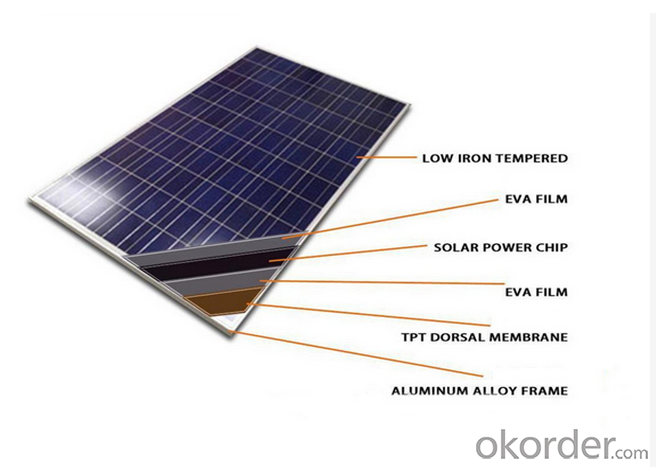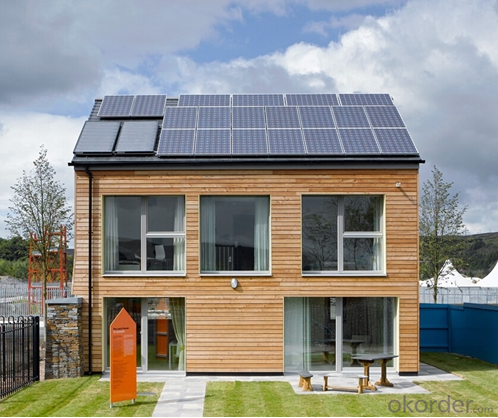260 Watt Photovoltaic Poly Solar Panels supplier
- Loading Port:
- China main port
- Payment Terms:
- TT or LC
- Min Order Qty:
- 1000 watt
- Supply Capability:
- 500000 watt/month
OKorder Service Pledge
OKorder Financial Service
You Might Also Like
Item specifice
Instruction
Quality and Safety
1. Rigorous quality control meets the highest international standards.
2. High-transmissivity low-iron tempered glass, strong aluminium frame.
3. Using UV-resistant silicon.
4. IS09001/14001/CE/TUV/UL
5.3w-300w mono & poly solar panel supply
Warranties
1. 10 years limited product warranty
2. 15 years at 90% of the minimal rated power output
3. 25 years at 80% of the minimal rated power output
Feature
1. High efficiency and High power.
2. Long-term electrical stability.
3. Lowest price and Fastest delivery.
4. Good quality and good service.
5.Bulk supply
6. Good Warranty
7.Big Sale
8.High quality
9.More than 35 years on the lifetime.
10 DHL/Fedex/UPS/TNT/EMS etc
Images


Specification
Model | SIM-100 |
Maximum Power at ST(Pmax)W | 100Wp |
Maximum Power Voltage(Vmp)V | 18.0V |
Maximum Power Current(Imp)A | 5.56A |
Open Circuit Voltage(Voc)V | 22.0V |
Short Circuit Current(Isc)A | 5.9A |
Cell Efficiency(%) | 17.0% |
Module Efficiency(%) | 15.37% |
Operating Temperature°C | -40°C to 85°C |
Maximum system voltage | 1000V(IEC)DC |
Power tolerance | -0.03 |
Temperature coefficients of Pmax | -0.45%/°C |
Temperature coefficients of Voc | -0.27%/°C |
Temperature coefficients of Isc | 0.05%/°C |
Weight(kg) | 7.4 |
Number of cell(pcs) | 4*9 |
FAQ
We have organized several common questions for our clients,may help you sincerely:
1). What’s price per watt?
A: It’s depends on the quantity, delivery date and payment terms of the order. We can talk further about the detail price issue. Our products is high quality with lower price level.
2). Can you tell me the parameter of your solar panels?
We have different series of cells with different power output, both from c-si to a-si. Please take our specification sheet for your reference.
3). How do you pack your products?
We have rich experience on how to pack the panels to make sure the safety on shipment when it arrives at the destination.
4). How long can we receive the product after purchase?
In the purchase of product within three working days, We will arrange the factory delivery as soon as possible. The perfect time of receiving is related to the state and position of customers. Commonly 7 to 10 working days can be served.
What’s a typical solar panel efficiency rating?
Most solar panels are around 11-15% efficient, The efficiency rating measures what percentage of sunlight hitting a panel gets turned into electricity that we can use. The higher the efficiency, the less surface area you’ll need in your solar panels. Although the average percentage may sound a little low, you can easily outfit a typical roof with enough power to cover your energy needs.
What are the most efficient solar panels?
In the lab, scientists have developed solar panels that are 40% efficient, or even slightly more than that. But there’s a big difference between the lab and the real world. Manufacturers haven’t yet figured out how to take these experiments and produce economically viable products. Thinking you should wait for new whiz-bang panels is one of the most common solar myths.
Should I choose the most efficient solar panels available?
High efficiency doesn’t mean better, it just means your panels use less space on your roof. Efficiency isn’t usually a critical concern unless you have an unusually small space for your solar panels. The most efficient solar panels cost a little more, so they’re a less common choice.
Factors that affect solar array efficiency include:
Panel Orientation
In the U.S., your roof ideally should face south, but a quality design can often compensate for other directions.
Roof and Panel Pitch
The “pitch” or tilt of your roof can affect the number of hours of sunlight you receive in an average day throughout the year. Large commercial systems have solar tracking systemsthat automatically follow the sun’s tilt through the day. These are expensive, however, and not typically used for residential solar installs.
Temperature
Some panels like it hot but most don’t. So, panels typically need to be installed a few inches above the roof with enough air flow to cool them down. Some photovoltaic panels are designed to be more efficient in hotter climates. Hot temperatures can reduce the efficiency of solar panels.
Shade
Basically, shade is the enemy of solar panel efficiency. With poor solar design, even a little shade on one panel can shut down energy production on all of your other panels (like a bad bulb in a string of Christmas lights). Before we design a system for your home, we’ll conduct a detailed shading analysis of your roof to reveal its patterns of shade and sunlight throughout the year. Then, our local installation partner conducts another detailed analysis to verify our findings. This is just one of many reasons to work with a highly experienced solar provider like.
For more on solar cell efficiency, go back to the Different Types of Solar Panels. Want to know more about what goes into a solar PV system? See our next page.
- Q:How are solar cells used in spacecraft?
- Solar cells are used in spacecraft to convert sunlight into electricity, providing a reliable and renewable source of power for various systems and instruments on board.
- Q:How about the solar cell 156mm Mono-Crystalline?
- It is the kind of solar cells That is unobstructed sunlight of the outdoor environment and it can be Operated under the temperature between -20 ℃ to +85 ℃
- Q:How do solar cells handle partial shading?
- Solar cells handle partial shading by using bypass diodes. These diodes allow the current to bypass the shaded area, ensuring that the rest of the solar cell continues to function efficiently. By redirecting the current, the solar cells can still generate power even if some parts are shaded, minimizing the impact of partial shading on overall performance.
- Q:Are bulk solar cells better than the normal solar cells?
- Yes, the bulk solar cells are better than normal solar cells because its power supply is bigger than the normal solar cells.
- Q:Solar cell life for several years
- Solar battery life of about ten years, the replacement is very convenient. Solar cells, also known as "solar chips" or "photovoltaic cells", is a direct use of solar photovoltaic power semiconductor thin film. As long as it is light to, and instantly can output voltage and in the case of a loop generated current.
- Q:Doping and Diffusion Principle in Solar Cell Processing
- In some inorganic solid compounds doped with different metal ions, can be different properties of luminescent materials, such as yttrium oxide (III) doped with europium (III) ions can be red fluorescent materials.
- Q:Can solar cells be recycled?
- Yes, solar cells can be recycled. The process involves separating the different components, such as glass, metals, and semiconductors, and reusing or repurposing them for new solar cell production or other industries. Recycling solar cells helps reduce waste and environmental impact while also conserving valuable resources.
- Q:Can solar cells be used in mining operations?
- Yes, solar cells can be used in mining operations. They can provide a sustainable and cost-effective source of energy for various mining activities, such as powering equipment, lighting, and ventilation systems. Additionally, solar cells can be integrated with energy storage solutions to ensure uninterrupted power supply, even in remote mining locations. By using solar cells, mining operations can reduce their reliance on fossil fuels, decrease their carbon footprint, and contribute to a more sustainable mining industry.
- Q:Can solar cells be used in military vehicles?
- Yes, solar cells can be used in military vehicles. They can provide an alternative source of energy to power various systems and equipment, reducing reliance on traditional fuel sources and enabling greater operational flexibility and sustainability. Additionally, solar cells can help extend the range and endurance of military vehicles in remote or austere environments where access to conventional fuel supplies may be limited.
- Q:Can solar cells be used in powering remote weather stations?
- Yes, solar cells can be used to power remote weather stations. Solar cells convert sunlight directly into electricity, making them an ideal and sustainable power source for remote locations where access to the electrical grid may be limited or non-existent. The solar panels can be installed on the weather station's roof or nearby, providing a constant supply of renewable energy to run the station's sensors, data loggers, and communication systems.
1. Manufacturer Overview |
|
|---|---|
| Location | |
| Year Established | |
| Annual Output Value | |
| Main Markets | |
| Company Certifications | |
2. Manufacturer Certificates |
|
|---|---|
| a) Certification Name | |
| Range | |
| Reference | |
| Validity Period | |
3. Manufacturer Capability |
|
|---|---|
| a)Trade Capacity | |
| Nearest Port | |
| Export Percentage | |
| No.of Employees in Trade Department | |
| Language Spoken: | |
| b)Factory Information | |
| Factory Size: | |
| No. of Production Lines | |
| Contract Manufacturing | |
| Product Price Range | |
Send your message to us
260 Watt Photovoltaic Poly Solar Panels supplier
- Loading Port:
- China main port
- Payment Terms:
- TT or LC
- Min Order Qty:
- 1000 watt
- Supply Capability:
- 500000 watt/month
OKorder Service Pledge
OKorder Financial Service
Similar products
New products
Hot products
Hot Searches
Related keywords



























